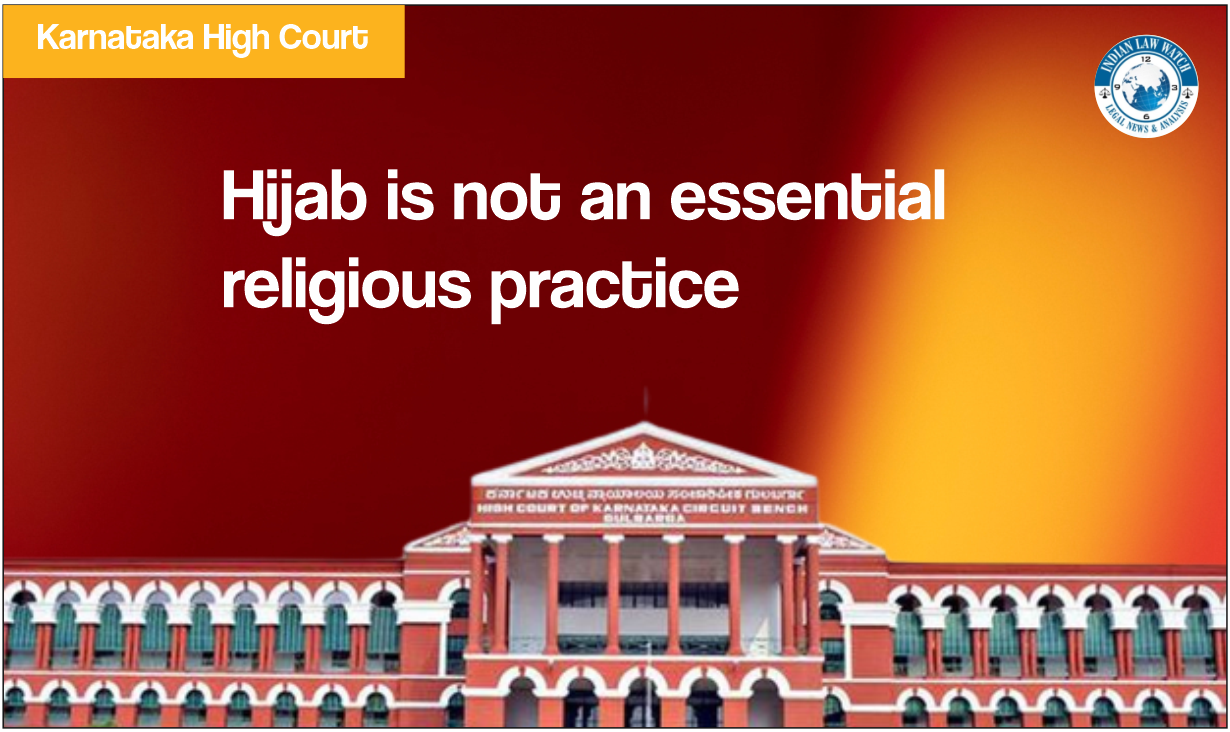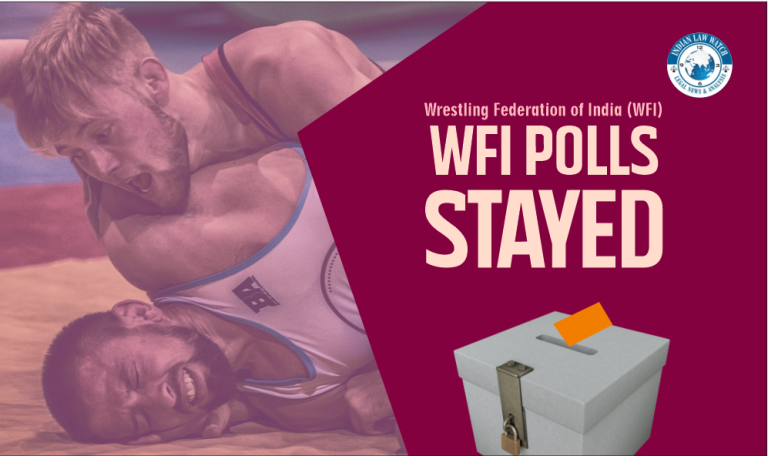

The Karnataka High Court in Smt. Resham & Anr. v. State of Karnataka & Ors., has recently held that hijab is not an essential religious practice and the exclusion of the same from school uniform does not violate Articles 14, 15, 19(1)(a), and 21 of the Indian Constitution. However, the said decision has been challenged by the petitioners before the Supreme Court. The order has been challenged in the Supreme Court by Niba Naaz, a student who was not among the five who had originally petitioned against the hijab ban.
 Contentions of the Petitioner
Contentions of the Petitioner
The petitioner contended that hijab is an essential religious practice of Islam as recognized in Amnah Bint Basheer v. Central Board of Secondary Education and Ajmal Khan v. Election Commission of India. The respondent schools while insisting upon removal of hijab is therefore, a violation of the fundamental right provided under Article 25 of the Indian Constitution as held in Sri Venkataramana Devaru v. State of Mysore and Indian Young Lawyers Association v. State of Kerala. The petitioner challenged the G.O. on the ground that while holding hijab is not an essential religious practice, such order violates the right to practice religious faith under Article 25 of the Indian Constitution, as recognized in Bijoe Emmanuel v. State of Kerala. The petitioner also alleged that such practice is also violative of Articles 14 and 15 of the Constitution.
The petitioner further disregarded the jurisdiction of Rule 11 of the Karnataka Educational Institutions Rules, 1995 and the dress code prescribed by the College Betterment (Development) Committee. Moreover, the College Betterment (Development) Committee, comprising of local members of legislative assembly is violative of the ‘doctrine of separation of powers’. The petitioner also attempted to rule out the argument of ‘public order’ on the ground that if wearing of hijab is the reason for disruption of public order, the State must discharge its positive duty of taking action against those who disrupt public order. The petitioner placed reliance on Gulam Abbas v. State of Uttar Pradesh and Indibily Creative Pvt. Ltd. v. State of West Bengal.
Contentions of the Respondent
The respondents contended that wearing of hijab or headscarf is not an ‘essential religious practice’ and placed reliance on Commissioner Hindu Religious Endowments (Madras) v. Sri Lakshmindra Thirtha Swamiar of Sri Shirur Mutt, M. Ismail Faruqui v. Union of India, Ajmal Khan v. Election Commission of India, and so on. Therefore, it cannot be claimed by students as a matter of right.
The respondent further averred that educational institutions being ‘qualified public places’, the students are expected to adhere to the prescribed dress code and campus discipline. The respondent supported its argument by holding that the power to prescribe school uniform is vested in the concept of school education itself and the 1983 Act along with the 1995 Curricula indicate the same. The respondent defended the validity of the G.O. dated 05.02.2022 on the ground that it gave effect to constitutional secularism and ideals enshrined in Articles 39(f) and 51(a) of the Indian Constitution.
The respondent also contended that the petitioner cannot claim the right to wear hijab under Articles 19(1)(a) and 25 both as they are mutually exclusive and denuding of each other. Moreover, every right is subject to reasonable restrictions as held in Chintaman Rao v. State of Madhya Pradesh and Mohd. Faruk v. State of Madhya Pradesh.
 Question before the Court
Question before the Court
The questions that came up for consideration of the Court were:
(i) Whether wearing of hijab is an essential religious practice of Islam and therefore, protected by Article 25 of the Indian Constitution?
(ii) Whether prescription of school uniform is not legally permissible for being violative of the fundamental rights enshrined in Articles 19(1)(a) and 21 of the Indian Constitution?
(iii) Whether G.O. dated 05.02.2022 is incompetent, arbitrary, issued without application of mind, and therefore, violative of Articles 14 and 15 of the Indian Constitution?
(iv) Whether any case is made out for issuance of a writ of quo warranto against respondent no. 15 and 16(Authorized and Unauthorized chairman of CDMC)?
 Secularism and Freedom of Conscience & Religion under our Constitution
Secularism and Freedom of Conscience & Religion under our Constitution
The Karnataka High Court referred to the Kesavananda Bharati case, 42nd Amendment to the Constitution, SR Bommai case, and Indira Nehru Gandhi v. Raj Narain to trace the spirit of secularism imbibed in our Constitution. No doubt secularism has been a basic feature of our Constitution forever and the same has been acknowledged by aforesaid authorities. However, the decision of State of Karnataka v. Praveen Bhai Thogadia made further addition to the constitutional jurisprudence by holding that our Constitution advocates for positive secularism and therefore, it is not antithesis of religious devoutness but comprises religious tolerance. The Karnataka High Court thereafter, made a reference to duty prescribed by Article 51A(e) of the Indian Constitution and same being performed by section 7(2)(v) and (vi) of the 1983 Act.
Constitutional Right to Religion and Restrictions thereon
The Karnataka High Court compared the freedom of religion guaranteed by Articles 25 & 26 of the Indian Constitution with the American and Australian jurisprudence of the same. The comments made by Prof. Upendra Baxi in his book ‘The Future of Human Rights’ and Dr. DD Basu in his ‘Commentary on the Constitution of India’ on the religious freedom guaranteed by the Indian Constitution were considered. Later, the decision of American Supreme Court in Davis v. Beason, views of Will Durant, an American historian, comment made by Bertrand Russell in his ‘Education and Social Order’, and various authorities were cited to elucidate the American jurisprudence over religious freedom. The Court observed that:
“…in the United States and Australia, the freedom of religion was declared in absolute terms and courts had to evolve exceptions to that freedom, whereas in India, Articles 25 & 26 of the Constitution appreciably embody the limits of that freedom”.
Protection of Essential Religious Practice and the Test for its ascertainment
While placing reliance on the decisions passed by the Supreme Court in Commissioner of Police v. Acharya Jagdishwarananda Avadhuta and Indian Young Lawyers Association, observed that for a religious practice to qualify as an ‘essential religious practice’ should satisfy the following criteria:
(i) Practice should be fundamental to religion and it should be from time immemorial.
(ii) Foundation of the practice must precede religion itself or should be co-founded at the origin of the religion.
(iii) Such practice must form the cornerstone of the religion and if not followed, it would amount to change of religion, and
(iv) Such practice must be of binding nature.
It was observed that if essential religious practice as a requirement is not met, the question of challenge to constitutional values does not arise at all.
Whether hijab is an essential religious practice?
The Court placed its reliance on various surahs and verses of Holy Quran and ‘The Holy Quran: Text, Translation, and Commentary’ by Abdullah Yusuf Ali for their authenticity and reliability. The Court observed that the Holy Quran does not mandate wearing of hijab and it is directory for there is no penalty or penance for non-compliance of the same. It is merely a means to access public places and does not serve any religious end. Thereafter, the observation made in Indian Young Lawyers Association that for a practice to be an essential religious practice must be of an obligatory nature, was considered.
The Court also took note of the fact that the practice of veiling is not Islam-specific as Sara Slininger from Centralia, Illinois in her research paper ‘Veiled women: Hijab, Religion, and Cultural Practice’ has cited examples of other communities that adopted the practice of veiling their women. The Court took note that the era before origin of Islam was jahilya – an era of ignorance and barbarism. Therefore, the Holy Quran might have recommended wearing of hijab as a social security measure. The Court placed its reliance on the question asked by Abdullah Yusuf Ali i.e. Are these conditions present among us today?
Based on the above considerations, the Karnataka High Court held that wearing of hijab is not an essential religious practice in Islam. With respect to treating the practice as imbibed in the freedom of conscience under Article 25 of the Indian Constitution, the Court observed that:
“Whether the petitioners had the conscience of the kind and how they developed it are not averred in the petition with material particulars. Merely stating that wearing hijab is an overt act of conscience and therefore, asking them to remove hijab would offend conscience, would not be sufficient for treating it as a ground for granting relief.”
The Court distinguished the present case from Bijoe Emmanuel on the ground that the latter did not demarcate the boundaries between ‘freedom of conscience’ and ‘right to practice religion’.
Power to prescribe school uniform
The Court rejected the contention of the petitioner that there is absence of power to prescribe dress code in schools. It was observed that the idea of schooling is incomplete without teachers, taught and the dress code. The concept of school uniform is not of a nascent origin. It existed since ancient times by the term ‘samavastr/shubhravesh’ (sanskrit) and not a foreign concept brought by Moghuls or Britishers.
Whether exclusion of hijab from school uniform violates Articles 14, 15, 19(1)(a), and 21 of the Indian Constitution?
It was held that there is no case for alleging manifest arbitrariness or discrimination under Articles 14, 15, 19(1)(a) and 21 of the Indian Constitution when the uniform is applicable to all students, irrespective of their religion, language, gender, or like. Therefore, the prescription of school uniform was held to be a reasonable restriction constitutionally permissible which the students cannot object to.
Whether G.O. dated 05.02.2022 is valid?
The High Court upheld the validity of the same order and no case is made out for its invalidation as it does not prescribe any dress code and prescription of uniform in 4 types of educational institutions was made. Moreover, the order being passed in a haste is a weak ground to render it invalid. Lastly, the Court held that no case for issuance of a writ of Quo warranto is made out against the concerned respondents.





